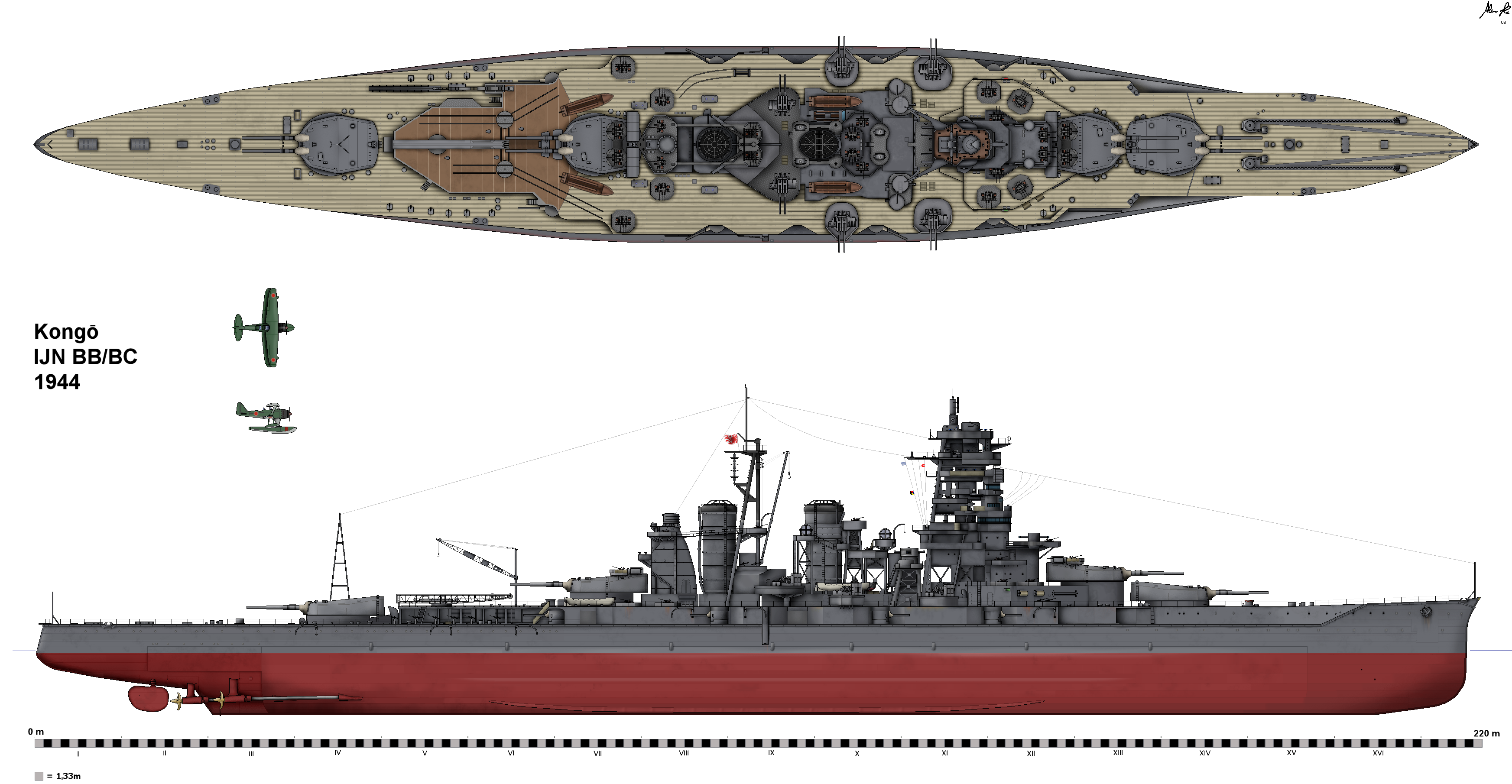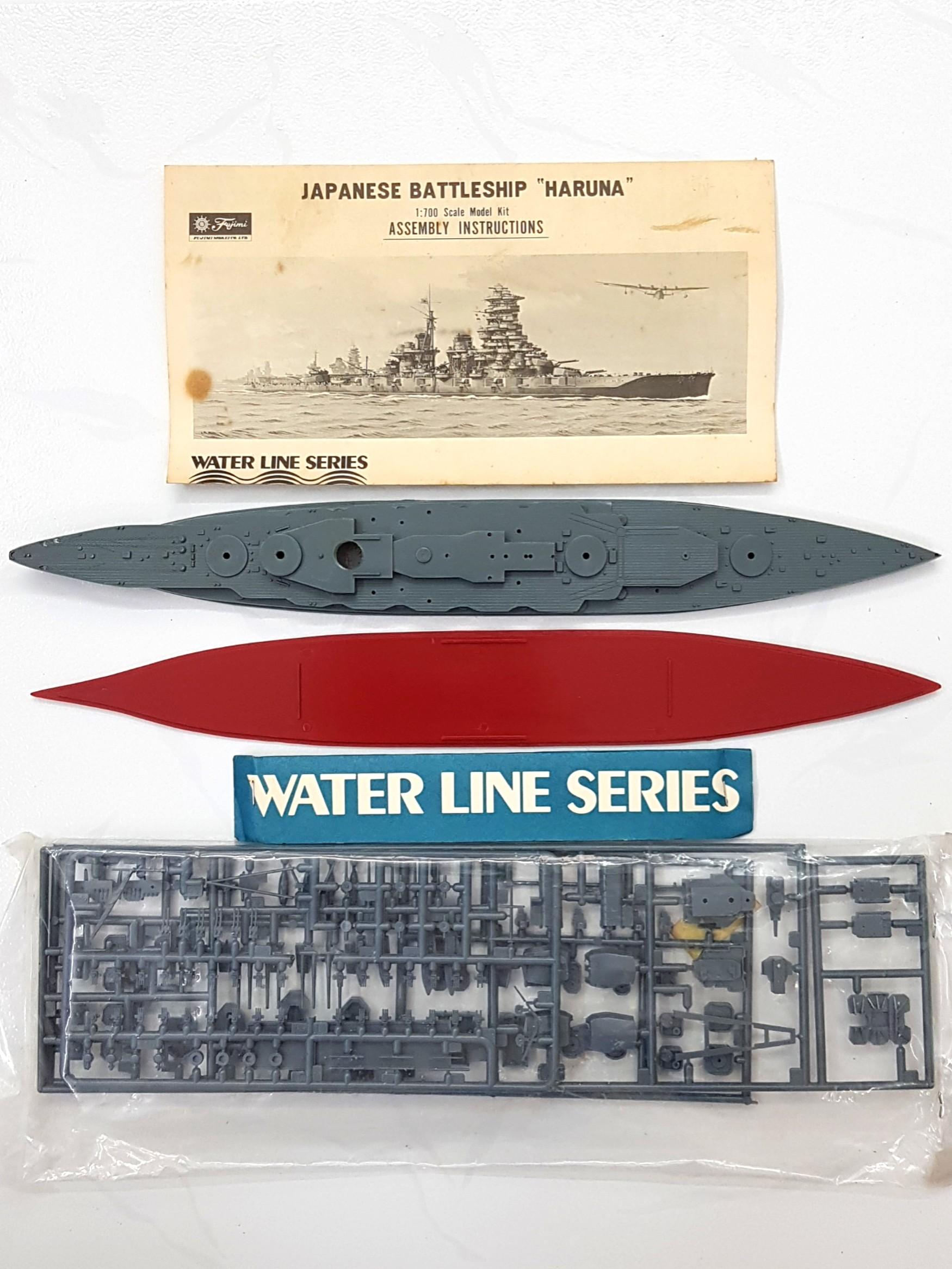Kongo Class Battleships - The Kongo-class battleships (金剛型巡洋 Kong, Kongō-gata jun'yōskan) were a class of four battlecruisers built for the Imperial Japanese Navy (IJN) immediately before World War I. Kongo, the flagship of the class, designed by British naval architect George Thurston, was the last Japanese ship to be built outside Japan, by Vickers at Barrow-in-Furness.
In the late 1970s, all but Hiei were rebuilt and refitted as warships. After the London Naval Treaty was signed in 1930, Haiku was rebuilt as a training ship to avoid being scrapped. After Japan's withdrawal from the treaty, the Four undertook a second major reconstruction in the late 1930s. After completion of this modification, which increased the top speed to 30 knots (56 km/h; 35 mph), the four were classified as fast. battleship
Kongo Class Battleships

During World War II, the Japanese Navy's Kongo-class battleships participated in most of the active battles. Hie and Kirishima served as escorts for the attack on Pearl Harbor, while Kongo and Haruna supported the attack on Singapore. All four participated in the Battles of Midway and Guadalcanal Both Hi and Kirishima were lost during the naval Battle of Guadalcanal in November 1942, when Haruna and Kongo jointly attacked the US air base at Hudson Field on Guadalcanal. The remaining two Kongo-class battleships spent most of 1943 covering Japanese naval bases before participating in the major naval campaign of 1944. During the Battle of Leyte Gulf in late October 1944, Haruna and Congo covered American ships. USS Sealion in November 1944, when Haruna sank in her bunker during an air raid on Kure Naval Base in late July 1945, but was later raised in 1946.
Ijn Kongo Bc/bb
The design of the Kongo-class battleships came in line with the IJN's modernization plans, and the need to compete with the British Royal Navy.
In April 1907, the Royal Navy launched HMS Invincible at Newcastle upon Tyne. Armed with eight main 12-inch (30.5 cm) guns, the Invincible was designed to be comparatively obsolete, defeating all of Japan's capital ships.
In 1911, the Japanese Diet passed the Emergency Naval Expansion Bill, which authorized the construction of one battleship (Fuse) and four battleships to be designed by British naval architect George Thurston.
In his class design, Thurston relied on many techniques that the British would use on HMS Tiger.
Fusō Class Battleship
Under the terms of the agreement signed by Vickers in November 1910, the flagship Congo - a member of the Kongo class - was to be built in England and Vickers was to provide advanced naval technology to Japan. The design of the ships was based on the Vickers Design 472C (similar to the design of the Japanese B-46). The original design, known as the "Ishizuchi", had 50-caliber 12-inch (304.8 mm) guns, six 6-inch (152 mm) guns, and eight 21-inch (533 mm) torpedo tubes. Commander Kato Hirohasu proceeded to receive a new 14-inch (356 mm)/45 gun that was under development. After trials of the new gun witnessed by the Japanese Navy and the Imperial Navy, the Japanese decided to use the new gun on 29 November 1911, but the keel was installed on 17 January 1911 and the result required. To make a large number of design changes quickly, so as not to increase construction time Due to the size of the gun only 8 were installed and the aircraft was installed in place of the additional turret
The final Battleship design became an improved version of the Lion class, displacing approximately 27,940 tons (27,500 long tons).
It also called for eight 14-inch guns mounted on four gun turrets (two forward and two aft) at 27.5 knots (50.9 km/h; 31.6 mm).

More than 100 technical experts were sent 18 seconds from Japan to Vickers during the Congo construction phase to ensure the transfer of the latest design know-how to Japan. If managers, supervisors and trial witnesses will also be included in the UK around 200 Japanese times.
Wolfs Shipyard Forum • View Topic
The ships were 214.58 meters (704 ft 0 in) and 28.04 meters (92 ft 0 in) in length. They had a draft of 8.22 m (27 ft 0 in) and displaced 27,384 metric tons (26,952 t) at normal loading.
Kongo-class ships had two sets of direct-drive Parsons steam turbines, each driving two propeller shafts, in addition to Haruna's Brown-Curtis turbine. High-pressure turbines drive the wing shafts, while low-pressure turbines drive the inner shafts. The machines were arranged in two sections, separated by a large longitudinal cutterline head; Betway Tourette numbers 3 and 4 in both divisions They were designed to produce a total of 65,000 horsepower (48,000 kW), using steam supplied by Yarrow 36 or Campan water tube boilers at operating pressures of 17.1 to 19.2 atm (1,733 to 1,945 kPa; 251 to 282 psi).
The boilers, arranged in eight sections, were mixed with fuel oil sprayed on the coal for extra power. The ships were capable of storing 4,200 long tons (4,300 t) of coal and 1,000 t of fuel, giving them a range of 8,000 nautical miles (15,000 km; 9,200 mi) at a speed of 14 knots (26 km/h; 16 mph). )
The battleships were designed to reach a speed of 27.5 knots (50.9 km/h; 31.6 mph) and all exceeded that speed in their sea trials. Congo and Hai achieved 78,275 SHP (58,370 kW) and 76,127 SHP (56,768) at 27.54 knots (51.00 km/h; 31.69 mm) and 27.72 knots (51.34 km/h; 31.90 mm). respectively
Amazon.com: Hasegawa 1/700 Ijn Battleship Kongo Hsg49109
In their first construction in the late 1970s, the ships were reboiled with 10, 11 (Hii) or 16 (Haruna) Kampon boilers and refueled to carry 2,661 long tons (2,704 t) of coal. 3,292 long tons (3,345 tons) of oil This increased their range to 8,930 nautical miles (16,540 km; 10,280 mi) at 14 knots and allowed the removal of the forward funnel, which greatly reduced smoke interactions with the bridge and fire control systems. With the addition of external torpedo tubes, this reduced their speed to 26 knots (48 km/h; 30 mph) and led the IJN to reclassify them as battleships.
During their 1930s construction on fast warships, the existing boilers were removed and replaced with oil-fired Kampon boilers.
These advanced boilers provided additional power to Kongo and her sister ships, with ships of the class capable of speeds in excess of 30.5 knots (56.5 km/h; 35.1 mph). This made them perfectly suited to work alongside fast aircraft carriers as Japan's only battleships

The primary armament of the Kongo class consisted of eight 14"/45" guns, mounted in four impressive twin gun turrets.
N3 Class Battleships (1920)
Turrets had an elevation capability of −5/+20 degrees except in the Congo, where the turrets had a maximum elevation capability of +25 degrees. Shell can be loaded at any angle
These guns and their turrets brought modernization to all aspects of the ship During the first construction of the class in the 1920s, the elevation of the main gun was increased to a maximum of +33 degrees The gun's recoil mechanism was also changed from a hydraulic system to a pneumatic one, which allowed for faster firing of the main gun.
By World War II, guns used Type 91 armored, sealed shells Each of these shells weighed 673.5 kg (1,485 lb) and had a velocity of 775 meters per second (2,540 ft/s). They had a maximum range of 25,000 meters (27,000 yd) at an altitude of +20 degrees.
It had a 625 kg (1,378 lb) explosive shell with a muzzle velocity of 805 meters per second (2,640 ft/s). In the 1930s, a special Type 3 Sanshikidan Incadiary shrapnel shell was developed for anti-aircraft use.
Fujimi Ijn Kongo Class Battleship Haruna * Vintage Set * (plastic Scale 2nd World War Sea Warfare Ship Model), Hobbies & Toys, Toys & Games On Carousell
As built, the Congo class was fitted with a secondary armament of six 15 cm/50 guns mounted in a cabinet on the side of the hull at upper deck level. Eight guns were mounted on each side and each had 130 degrees of fire and a maximum elevation of +15 degrees. Each gun could fire a 45.36 kg (100 lb) bomb at a maximum range of 22,970 yards (21,000 m) at a rate of four and six rounds per minute. During their construction in the 1930s, the maximum elevation of the guns was increased to +30 degrees, increasing their range to about 900 meters (980 yd).
The ships also mounted four 76 mm/40 anti-aircraft (AA) guns. The 76 mm gun (in 3) was in one mm Each of these guns had a maximum elevation of +75 degrees and could fire a 6 kg (13 lb) projectile at 680 m/s (2,200 ft/s) at a maximum altitude of 7,500 m (24,600 ft). )
The second weapon of the Kongo class changed a lot over time During the 1930s refurbishment, all 76 mm guns were replaced by eight 127 mm (5 in)/40 dual-purpose guns. These guns were mounted in four gun emplacements on both sides of the front and rear formations

Guns had limits on shooting targets
Meet The Uss Missouri: The Us Navy Battleship That Refused To Lose
Ijn kongo class, iowa class battleships, kongo class, kongo class battlecruiser, kongo class destroyer, where are the iowa class battleships now, montana class battleships, yamato-class battleships, uss iowa class battleships, kongo class battleship, king george v class battleships, kongo class fast battleship

0 Comments